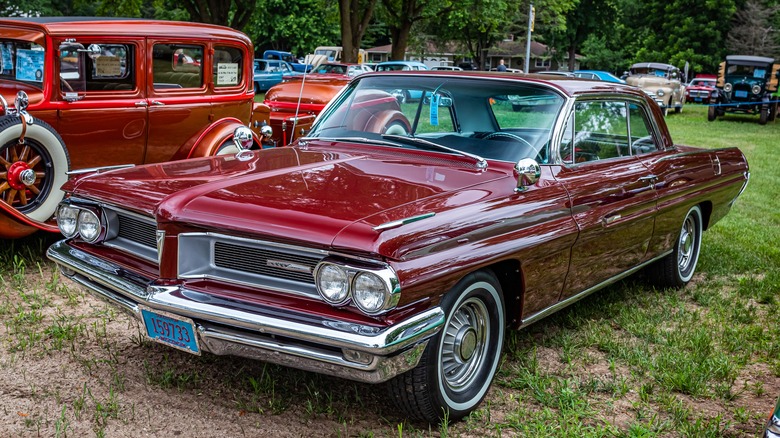
Gestalt Imagery/Shutterstock
Pontiac had some extreme highs and lows in its run from 1926 to 2009, when a government bailout prompted GM to drop the brand along with three others as part of its corporate restructuring. Pontiac’s crowning achievements included the 1964 GTO, the Firebird, which first hit the roads in 1967 and its cousin, the Trans Am. More forgettable models included the Fiero, which was true to its name in being prone to electrical fires, and the Aztek, which was panned for being ugly, although it may have simply come along too soon.
The Grand Prix made its first appearance in 1962 as a full-sized model but stayed in production on various platforms through 2008, making it one of Pontiac’s most enduring models ever. As expected for a car with that long of a run, the Grand Prix had some impressive years and some that left a bit to be desired. Also unsurprisingly, the fortunes of the Grand Prix largely paralleled those of the Pontiac brand at large.
The 1960s were great for the Grand Prix
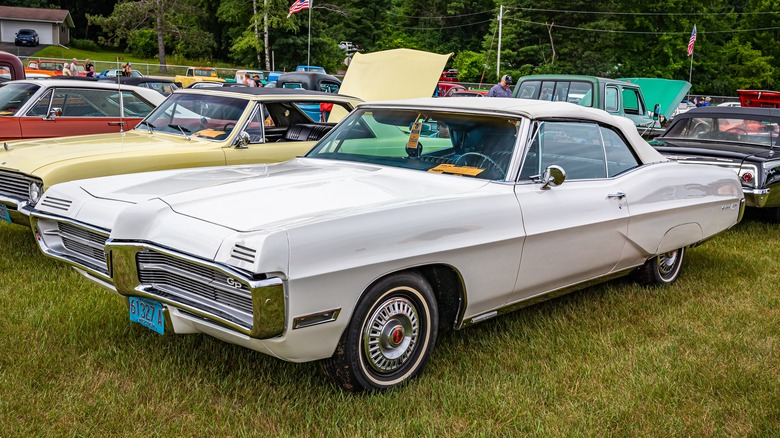
Gestalt Imagery/Shutterstock
The Pontiac Grand Prix hit the road with tires smoking in 1962. It was available in Super Duty trim with an available 421 cubic-inch V8 that could be topped with twin four-barrel Carter carburetors to make 405 horsepower. Premium interior touches included faux leather front bucket seats with optional power adjustment on the driver’s side, stereo speakers in back, and power windows.
Super Duty models got a 10-bolt rear axle with a 4.30:1 differential, and they could make 0-60 in six seconds flat. The next year, the Grand Prix accounted for almost one of every eight Pontiacs sold. By 1965, it had grown to nearly 18 feet long and 4,300 pounds. However, by 1966, the Grand Prix accounted for less than 5% of Pontiac’s sales, as competitors like the Ford Mustang and Thunderbird chipped away at the car’s market share.
The 1967 Grand Prix stands out among all model years solely for being the only vintage to have been issued in convertible form. Before departing to become the boss at Chevrolet in 1969, Pontiac general manager John DeLorean ordered a downsized version of the Grand Prix.
The Grand Prix became less desirable in the 1970s
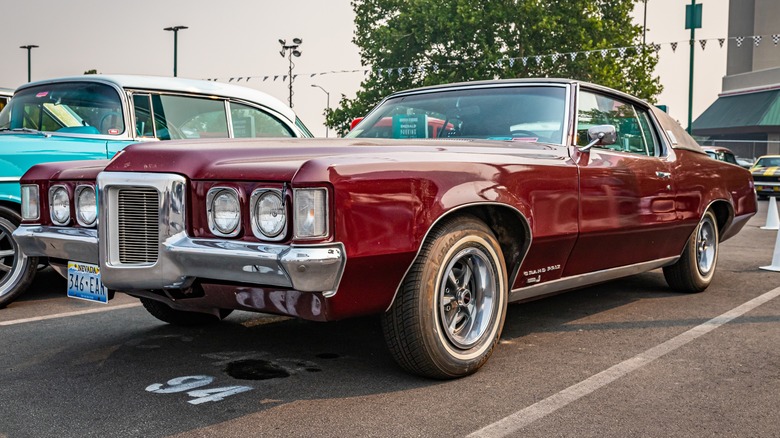
Gestalt Imagery/Shutterstock
Design changes to the underappreciated 1969 Pontiac Grand Prix made it smaller and lighter while focusing attention on the long hood. The 1969 Grand Prix was a driver’s car, with a heavily bolstered seat and large gauges tilted toward the left front. In High Output trim, the 1969 Grand Prix featured a 428 cubic-inch, 390-horsepower V8, four-speed manual transmission, and Positraction rear axle. Pontiac sold over 112,000 units of the Grand Prix that year.
With DeLorean gone to Chevy, the Grand Prix lost its way over the next couple of years. After the 1972 Pontiac Grand Prix came and went, the next update to the model arrived in 1973, just in time for the oil crisis that made cars of its size anachronistic. Pontiac celebrated its 50th year with a Golden Anniversary Grand Prix in 1976, but the embellishments were mostly in the form of badging. 1977 saw the addition of gewgaws like a digital stereo and optional CB radio, but the base engine that year was a 301-ci V8 that made an unimpressive 135 horsepower.
The Grand Prix stayed in the dumps through 1987
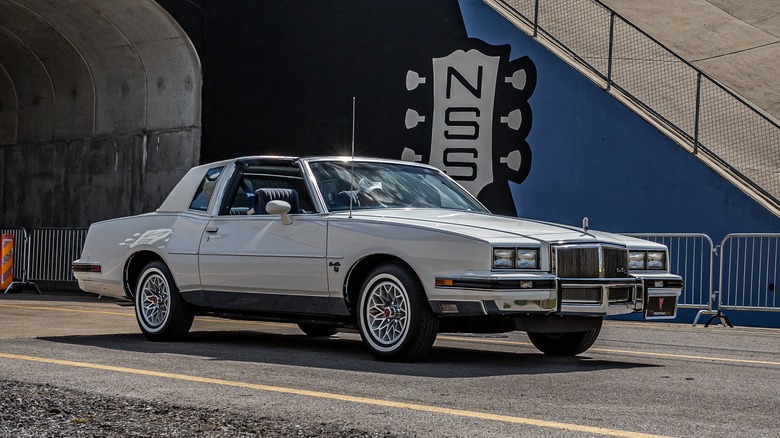
Gestalt Imagery/Shutterstock
In response to emerging emissions guidelines and Corporate Average Fuel Economy standards, Pontiac moved to even smaller engines beginning in 1978. The base motor was a 231-ci V6 capable of just 105 horses, and the most powerful engine option that year was a 301-ci V8 topped with a four-barrel carburetor that could still only make 150 horsepower.
The exterior redesign that year also stripped the Grand Prix of its imposing form, and the dashboard was an ungodly array of indistinguishable round gauges set in a faux wood-grain panel. Through 1987, the Grand Prix remained fairly underpowered, with its most potent engine being the 305 cubic-inch Chevy V8 that was used in 1985. «Potent» is a relative term here, as that motor made just 165 horsepower and 250 pound-feet of torque. Demand for the Grand Prix was waning by then, and production numbers dropped below 17,000 units in 1987.
The final Grand Prix generation was forgettable
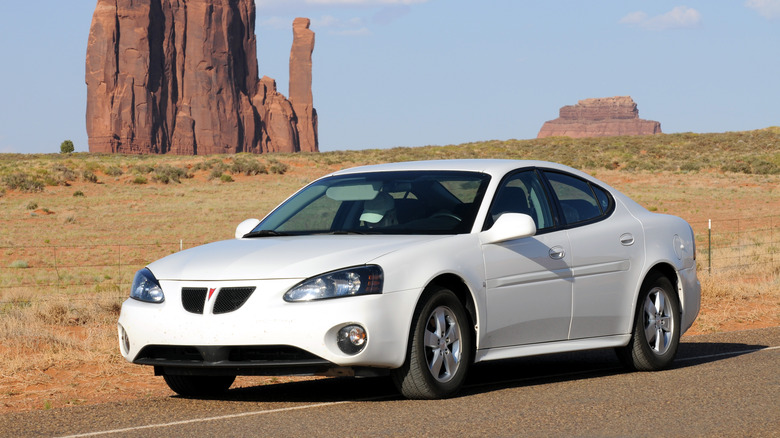
Frontpage/Shutterstock
The next major update to the Grand Prix came with the 1988 model year and included a shift to the front-wheel drive W-body platform. That year brought a Motor Trend Car of the Year Award win, thanks to the upgraded suspension, 2.8-liter V6 engine, and polished interior. Warren Brown of The Washington Post criticized the selection, pointing out that the Oldsmobile Cutlass Supreme and Buick Regal were essentially the same car. He acknowledged that the three models had «different ‘feels’ that appeal to different buyers,» but questioned how Motor Trend could distinguish one from the other two.
In 1989, a turbocharger was added to the 3.1-liter V6, boosting output to an impressive 205 horsepower. A 240-horsepower supercharged V6 appeared with the seventh generation in 1997, and the Grand Prix got 20 more horses with the final update in 2004. From 2005 through the end of the run in 2008, a GXP version with a 325 cubic-inch V8 was offered, but many owners of the last-generation Grand Prix have reported transmission solenoid issues that resulted in unpredictable shifting. Despite the availability of high-powered engines, these later-year Grand Prix models were emblematic of the decline of the Pontiac brand. The Grand Prix was dropped and replaced by the Pontiac G8 for the brand’s last year in 2009.